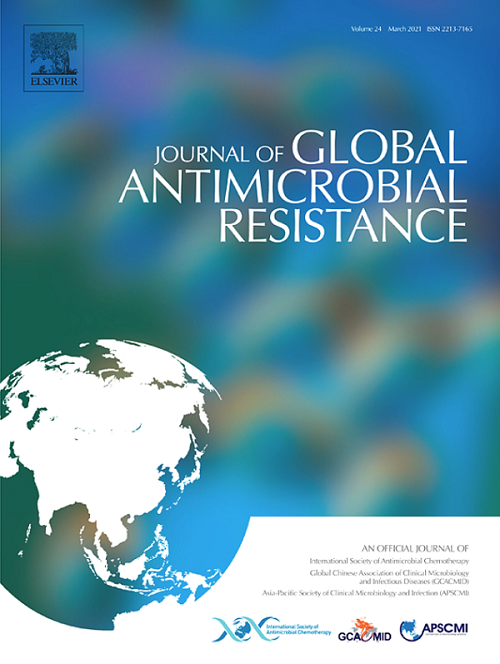Antimicrobial susceptibilities of oral Neisseria from men on HIV pre-exposure prophylaxis in Hanoi, Vietnam
IF 3.7
3区 医学
Q2 INFECTIOUS DISEASES
引用次数: 0
Abstract
Background
Antimicrobial resistance (AMR) in Neisseria gonorrhoeae (N. gonorrhoeae) is an urgent global health concern. Commensal Neisseria species in the oropharynx are an important reservoir of AMR genes that are transferred to N. gonorrhoeae, yet few data about AMR among commensal Neisseria in populations at risk for AMR exist.
Methods
From May 2022 to December 2023, men in an HIV pre-exposure prophylaxis program in Hanoi, Vietnam, were recruited for this study. Participants self-collected oral specimens using phosphate buffer solution, for culture on LB agar media containing sucrose, vancomycin, and trimethoprim (LBVT.SNR). Oxidase-positive Gram-negative diplococci were identified using the Remel RapID NH system. Minimum inhibitory concentrations (MICs) to azithromycin, ceftriaxone, cefixime, and doxycycline were determined using Etests.
Results
There were 42 male participants, the median age was 26 years and 29% (n = 12) reported using antibiotics in the past 6 months. In total, 48 Neisseria isolates were recovered; N. sicca/subflava was the most common species (50%; n = 24), followed by N. mucosa (38%; n = 18). For azithromycin, 85% (n = 41) of isolates were resistant with MICs ≥ 1 ug/mL, including 25% (n = 12) with high-level resistance (MICs ≥ 256 ug/mL of which 67% (8/12) were N. mucosa. Among non-gonococcal Neisseria isolates, the prevalence of resistance was 6% (n = 3) for ceftriaxone, 6% (n = 3) for cefixime, and 54% (n = 26) for doxycycline; the most non-susceptible isolates were N. mucosa.
Conclusions
A High frequency of azithromycin resistance, moderate doxycycline resistance, and low cephalosporin resistance was found in oropharyngeal Neisseria isolates from men who have sex with men (MSM) in a pre-exposure prophylaxis (PrEP) program in Hanoi, Vietnam. N. mucosa was over-represented among resistant isolates.
越南河内市接受HIV暴露前预防的男性口服奈瑟菌的抗菌药物敏感性
背景:淋病奈瑟菌(NG)的抗微生物药物耐药性(AMR)是一个紧迫的全球卫生问题。口咽部的共生奈瑟菌是转移到NG的AMR基因的重要储存库,但关于AMR风险人群中共生奈瑟菌的AMR的数据很少。方法:从2022年5月至2023年12月,招募参加越南河内HIV暴露前预防项目的男性。参与者使用磷酸盐缓冲液(PBS)自行收集口腔标本,在含有蔗糖、万古霉素和甲氧苄啶(lbvts . snr)的LB琼脂培养基上培养。采用Remel RapID NH系统对氧化酶阳性革兰氏阴性双球菌进行鉴定。用Etests测定对阿奇霉素、头孢曲松、头孢克肟和强力霉素的最低抑制浓度(mic)。结果:42名男性参与者,中位年龄为26岁,29% (n=12)报告在过去6个月内使用抗生素。共回收48株奈瑟菌;N. sicca/subflava是最常见的种(50%;n=24),其次是粘膜乳杆菌(38%;n = 18)。对于阿奇霉素,85% (n=41)的耐药菌株mic≥1 ug/ml,其中25% (n=12)的耐药菌株mic≥256 ug/ml,其中67%(8/12)为黏膜奈菌。在非淋球菌奈瑟菌分离株中,头孢曲松耐药率为6% (n=3),头孢克肟耐药率为6% (n=3),强力霉素耐药率为54% (n=26);非敏感株以粘膜乳杆菌为主。结论:越南河内某PrEP项目中MSM口咽奈瑟菌耐阿奇霉素、中度多西环素和低头孢菌素的频率较高。耐药菌株中粘膜乳杆菌的比例过高。
本文章由计算机程序翻译,如有差异,请以英文原文为准。
求助全文
约1分钟内获得全文
求助全文
来源期刊

Journal of global antimicrobial resistance
INFECTIOUS DISEASES-PHARMACOLOGY & PHARMACY
CiteScore
8.70
自引率
2.20%
发文量
285
审稿时长
34 weeks
期刊介绍:
The Journal of Global Antimicrobial Resistance (JGAR) is a quarterly online journal run by an international Editorial Board that focuses on the global spread of antibiotic-resistant microbes.
JGAR is a dedicated journal for all professionals working in research, health care, the environment and animal infection control, aiming to track the resistance threat worldwide and provides a single voice devoted to antimicrobial resistance (AMR).
Featuring peer-reviewed and up to date research articles, reviews, short notes and hot topics JGAR covers the key topics related to antibacterial, antiviral, antifungal and antiparasitic resistance.
 求助内容:
求助内容: 应助结果提醒方式:
应助结果提醒方式:


